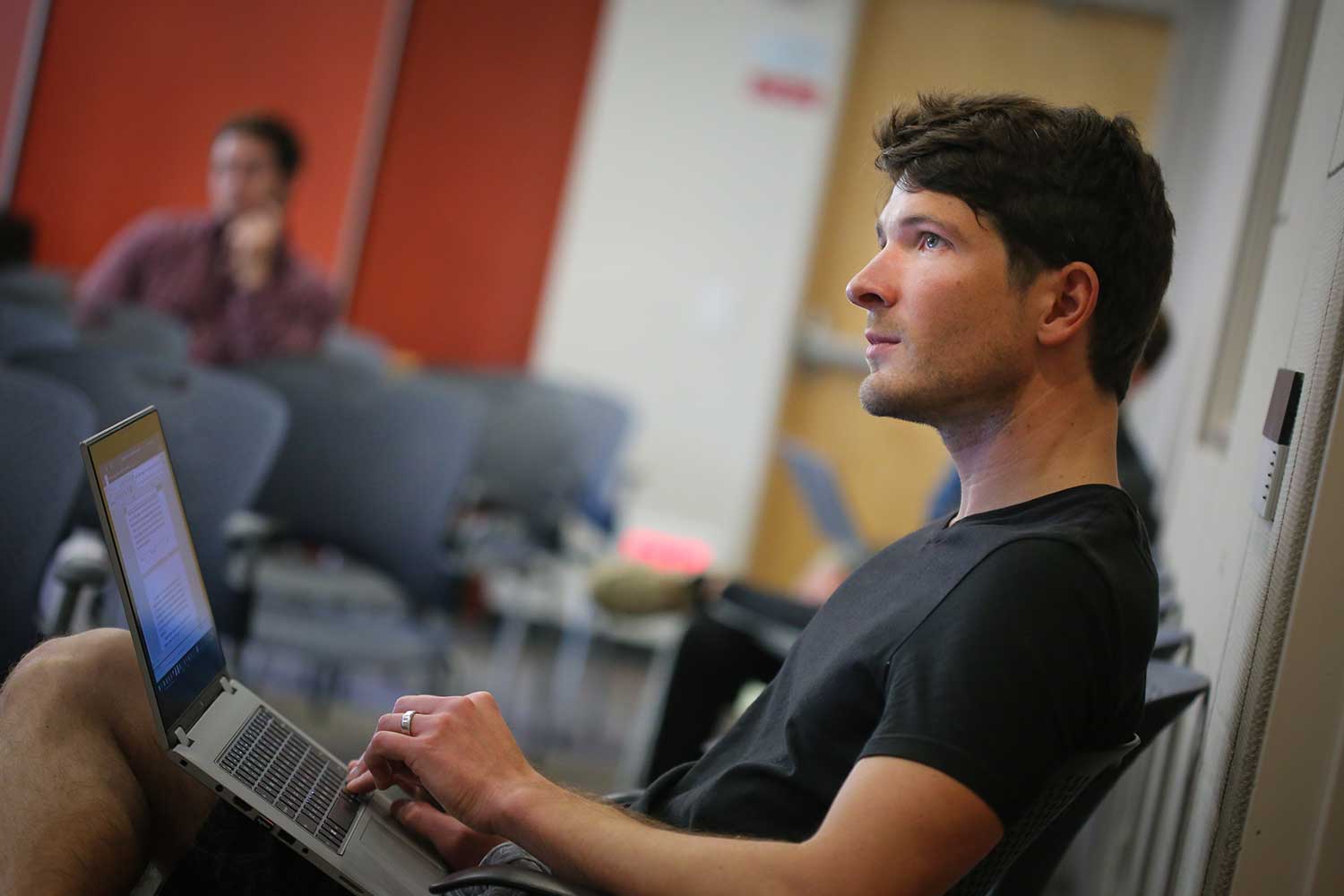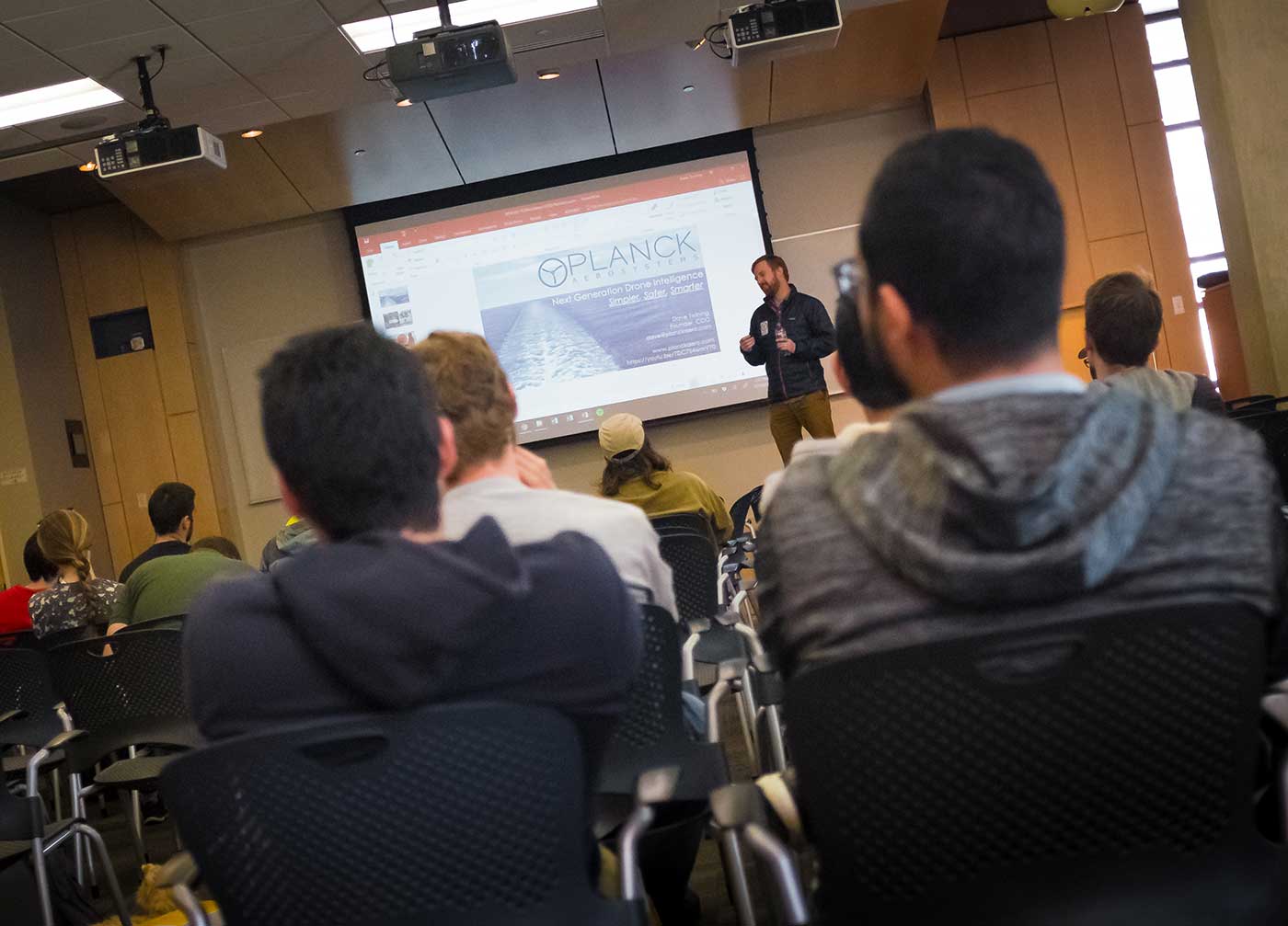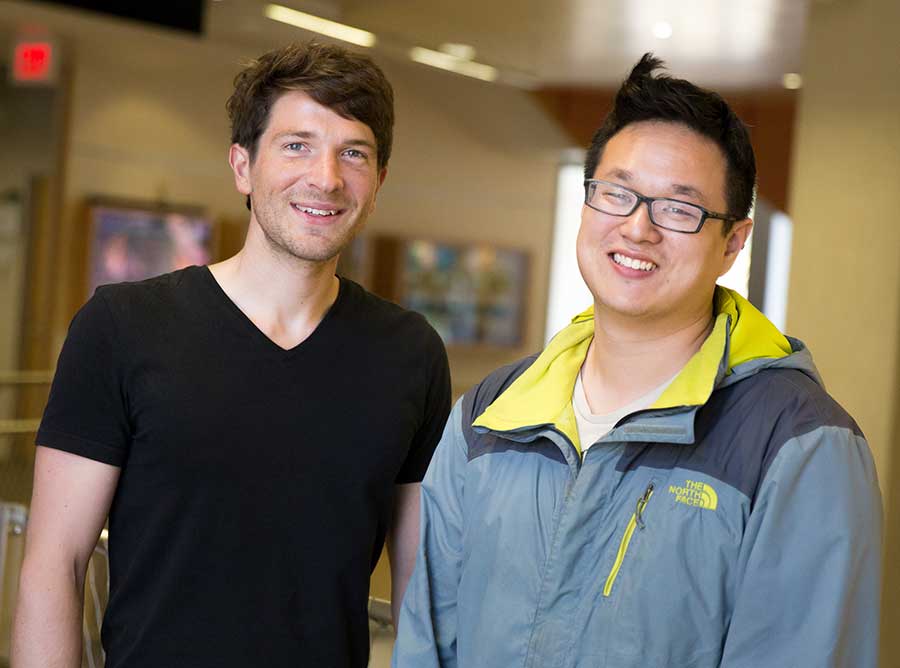By:
- Daniel Kane
Published Date
By:
- Daniel Kane
Share This:

UC San Diego nanoengineering Ph.D. student Caleb Christianson listens to a talk at the weekly robotics seminar he launched with mechanical engineering Ph.D. student Benjamin Shih. Photos by UC San Diego Jacobs School of Engineering / David Baillot
UC San Diego Grad Students Build a Robotics Community
Caleb Christianson was trying to track the motion of his eel-like robot through water. It wasn’t going particularly well. The robot that he’d built was moving just fine, but the image analysis was dragging. The Ph.D. student was trying to brute force the process – looking at images of his robot frame by frame, pixel by pixel.
“It was a computer vision application,” said Christianson, a UC San Diego nanoengineering Ph.D. student. “And I didn’t have any experience in that.”
What he did have was the right audience. He outlined these challenges in an informal research talk he gave to a group of other graduate students at UC San Diego who are interested in robotics. A student in the audience suggested a much better way to track the robot using MATLAB, a popular engineering programming software.
“We worked together on the solution, and it saved me a lot of time,” said Christianson.
This interaction captures a big part of what Christianson and mechanical engineering Ph.D. student Benjamin Shih were going for when they created the Association for Robotics Graduate Students here at UC San Diego at the end of 2016. Both Shih and Christianson are part of the Bioinspired Robotics and Design Lab led by mechanical engineering professor Mike Tolley.
“I knew what the other students in my lab were working on, but I had very little idea of what students in the next lab over were working on, or in other departments,” said Christianson. “There is this growing interest in robotics at UC San Diego. And one way to make it flourish is to build a community for the grad students.”
And build a community they did. At their weekly seminar, graduate students from 16 departments across campus have given research talks. The idea is for students to be able to share their research and get feedback from people from other departments, schools and divisions. At the seminars, students also hear from speakers from industry and academia.

Dave Twining, co-founder and COO of San Diego based Planck Aerosystems, speaks at a robotics seminar organized by the students
“If you are interested in working in robotics, you can come at it from a variety of different ways. You don’t need to do a robotics program specifically. You could study electrical engineering, computer engineering, mechanical engineering, or even nanoengineering,” said Christianson. “In the robotics group, we have people from cognitive science, health sciences, and visual arts. It takes all different backgrounds, interests, and experiences working together to do something as big and interdisciplinary as robotics.”
One of the long term benefits, according to Shih, is having a regular space carved out to think big picture.
The association started in professor Tolley’s lab. They began inviting students from other groups to give research updates during regular lab meetings.
“We wondered what everyone else was doing,” said Shih.
Their ambitions eventually outgrew the venue. The students officially launched the association in September 2016, right in the middle of a campus-wide move to grow the faculty working in robotics, and robotics-related areas. With so many new robotics faculty setting up labs, “graduate students were dangling,” said Shih.
“It has been enlightening to see the variety of ways ‘robotics’ is manifested throughout the university,” said Andrea Frank, a computer science Ph.D. student in the UCSD Healthcare Robotics Lab run by computer science professor Laurel Riek. “We've had talks on topics as traditional as motion planning and self-driving cars and as tangential, at least to my perception of robotics, as electric elastomer actuators, which has been incredibly interesting and mind-broadening.”
Frank runs social events for the group, which she says, end up “leading to a lot of talk about research and collaboration, but in a much more casual way that inspires imaginative conjectures and speculation, free from the constraints of formal Q&As in seminars.”
Interactions with Robotics Companies
At one of their February seminars, Dave Twining, Co-Founder and COO of San Diego based Planck Aerosystems, presented some of the challenges and opportunities facing his company, which develops intelligent drone systems that are able to land on moving boats and moving trucks. Picture drones being dispatched from a craft to check in on wind turbines in the ocean. (Fun fact: Twining’s team had to figure out how to make sure their drones don’t get confused by their own shadows.)
“You’ve upped your test facility, especially for aircraft,” said Twining, noting the recent news that the Contextual Robotics Institute recently opened an aerodrome on campus.
When the questions and answers finished, Twining told the 50 graduate students in the audience, “We are hiring controls engineers, mechanical engineers, software engineers, computer vision people, robotics people.”
One of Jacobs School of Engineering students Planck Aerosystems had already connected with is electrical engineer Matt Epperson, who studies intelligent systems, controls and robotics.
“I've liked coming out and hearing about different non-intersecting areas of robotics research. A lot of the talks are aspects of robotics I wouldn't get in my day to day research,” said Epperson. “The group has been fantastic for me in the sense that it got my foot in the door with Planck which has been a tremendous learning experience.”
Strengthening the Institute

(L-R) UC San Diego nanoengineering Ph.D. student Caleb Christianson and UC San Diego mechanical engineering Ph.D. student Benjamin Shih
Shih and Christianson found an early ally in computer science professor Henrik C. Christensen, the director of the UC San Diego Contextual Robotics Institute. UC San Diego launched the Contextual Robotics Institute in 2015. Christensen, who joined UC San Diego the following year, was eager to help the students.
“Whether it’s autonomy, healthcare or manufacturing, we are focused on robotics advances that will actually make it out into the real world. And for that, our graduate students need to be working with each other, and with industry,” said Christensen, a professor in the Department of Computer Science and Engineering. “It’s gratifying to see our students stepping up and building out a meaningful student ecosystem.” Christensen holds the Qualcomm Chancellor’s Endowed Chair in Robotic Systems at UC San Diego.
“I am incredibly proud of Caleb and Ben,” said Tolley. “Robotics is an inherently interdisciplinary field, and no one researcher or research group can solve all of the problems. By building a community at UC San Diego, we are also building up the capability to tackle the most daunting robotics and automation challenges of tomorrow. The fact that the students are leading this charge is a great sign for the Contextual Robotics Institute.”
If you are a UC San Diego professor, researcher or student who interested in attending UC San Diego Association for Robotics Graduate Students events, contact Caleb Christianson c6christ@eng.ucsd.edu or Benjamin Shih at beshih@eng.ucsd.edu to join the mailing list or Facebook group.
First with financial support from the UC San Diego Graduate Student Association and now with funds from the UC San Diego Contextual Robotics Institute, the students run their weekly seminar, which includes lunch.
Share This:
You May Also Like
New Study Reveals Source of Rain is Major Factor Behind Drought Risks for Farmers
Science & EnvironmentStay in the Know
Keep up with all the latest from UC San Diego. Subscribe to the newsletter today.



